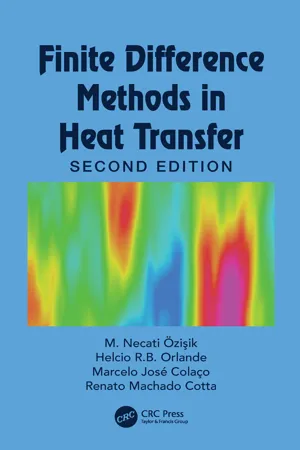
eBook - ePub
Finite Difference Methods in Heat Transfer
- 580 pages
- English
- ePUB (mobile friendly)
- Available on iOS & Android
eBook - ePub
Finite Difference Methods in Heat Transfer
About this book
Finite Difference Methods in Heat Transfer, Second Edition focuses on finite difference methods and their application to the solution of heat transfer problems. Such methods are based on the discretization of governing equations, initial and boundary conditions, which then replace a continuous partial differential problem by a system of algebraic equations. Finite difference methods are a versatile tool for scientists and for engineers. This updated book serves university students taking graduate-level coursework in heat transfer, as well as being an important reference for researchers and engineering.
Features
Frequently asked questions
Yes, you can cancel anytime from the Subscription tab in your account settings on the Perlego website. Your subscription will stay active until the end of your current billing period. Learn how to cancel your subscription.
At the moment all of our mobile-responsive ePub books are available to download via the app. Most of our PDFs are also available to download and we're working on making the final remaining ones downloadable now. Learn more here.
Perlego offers two plans: Essential and Complete
- Essential is ideal for learners and professionals who enjoy exploring a wide range of subjects. Access the Essential Library with 800,000+ trusted titles and best-sellers across business, personal growth, and the humanities. Includes unlimited reading time and Standard Read Aloud voice.
- Complete: Perfect for advanced learners and researchers needing full, unrestricted access. Unlock 1.4M+ books across hundreds of subjects, including academic and specialized titles. The Complete Plan also includes advanced features like Premium Read Aloud and Research Assistant.
We are an online textbook subscription service, where you can get access to an entire online library for less than the price of a single book per month. With over 1 million books across 1000+ topics, we’ve got you covered! Learn more here.
Look out for the read-aloud symbol on your next book to see if you can listen to it. The read-aloud tool reads text aloud for you, highlighting the text as it is being read. You can pause it, speed it up and slow it down. Learn more here.
Yes! You can use the Perlego app on both iOS or Android devices to read anytime, anywhere — even offline. Perfect for commutes or when you’re on the go.
Please note we cannot support devices running on iOS 13 and Android 7 or earlier. Learn more about using the app.
Please note we cannot support devices running on iOS 13 and Android 7 or earlier. Learn more about using the app.
Yes, you can access Finite Difference Methods in Heat Transfer by Helcio R. B. Orlande,Marcelo J. Colaço,Renato M. Cotta,M. Necati Özişik in PDF and/or ePUB format, as well as other popular books in Scienze fisiche & Energia. We have over one million books available in our catalogue for you to explore.
Information
1
Basic Relations
Numerical methods are useful for solving fluid dynamics, heat and mass transfer problems, and other partial differential equations of mathematical physics when such problems cannot be handled by exact analysis techniques because of nonlinearities, complex geometries, and complicated boundary conditions. The development of high-speed digital computers significantly enhanced the use of numerical methods in various branches of science and engineering. Many complicated problems can now be solved at a very little cost and in a very short time with the available computing power.
Presently, the finite difference method (FDM), the finite volume method (FVM), and the finite-element method (FEM) are widely used for the solution of partial differential equations of heat, mass, and momentum transfer. Extensive amounts of literature exist on the application of these methods for the solution of such problems. Each method has its advantages depending on the nature of the physical problem to be solved, but there is no best method for all problems. For instance, the dimension of the problem is an important factor that deserves some consideration because an efficient method for one-dimensional problems may not be so efficient for two- or three-dimensional problems. FDMs are simple to formulate and can readily be extended to two- or three-dimensional problems. Furthermore, FDM is very easy to learn and apply for the solution of partial differential equations encountered in the modeling of engineering problems for simple geometries. For problems involving irregular geometries in the solution domain, the FEM is known for having more flexibility because the region near the boundary can readily be divided into subregions. A major drawback of FDM used to be its difficulty to handle effectively the solution of problems over arbitrarily-shaped complex geometries because of interpolation between the boundaries and the interior points, in order to develop finite difference expressions for nodes next to the boundaries. More recently, with the advent of numerical grid generation approaches, the FDM has become comparable to FEM in dealing with irregular geometries, while still maintaining the simplicity of the standard FDM.
In this book, we ...
Table of contents
- Title Page
- Copyright Page
- Dedication
- Table of Contents
- Preface
- Preface—First Edition
- 1. Basic Relations
- 2. Discrete Approximation of Derivatives
- 3. Methods of Solving Systems of Algebraic Equations
- 4. One-Dimensional Steady-State Systems
- 5. One-Dimensional Transient Systems
- 6. Transient Multidimensional Systems
- 7. Nonlinear Diffusion
- 8. Multidimensional Incompressible Laminar Flow
- 9. Compressible Flow
- 10. Phase Change Problems
- 11. Numerical Grid Generation
- 12. Hybrid Numerical–Analytical Solutions
- Appendix A. Subroutine Gauss
- Appendix B. Subroutine Trisol
- Appendix C. Subroutine SOR
- Appendix D. Subroutine BICGM2
- Appendix E. Program to Solve Example 10.1
- Bibliography
- Index